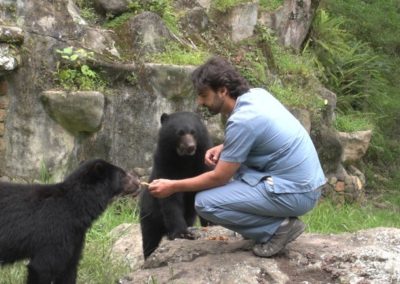The efforts of Fundación Biocontacto toward the conservation of the Andean bear (Tremarctos ornatus) in Venezuela began in 2004, with ex-situ work initiated at the Chorros de Milla Zoo in Mérida.
Since then, Biocontacto has evolved into a multidisciplinary initiative integrating research, rescue, community involvement, and applied conservation.
Patterns of Appearance
Between 2004 and 2021, the Merida Mountain Range recorded an average of one bear appearance per year, stemming from either confiscations or human-wildlife conflict situations. Of these, two individuals were successfully rehabilitated and released, six remained under care in zoos, and one died shortly after being confiscated.
Releases and Movement Monitoring
Monitoring activities in the Páramo Los Conejos study area have documented distinct seasonal patterns of bear sightings and activity traces at two altitudinal zones:
- March to August: Along the ecotone between cloud forest and páramo (2,200–3,500 m), sightings coincide with the flowering of Puya
- September to November: In lower deciduous forests (1,500–1,800 m), bear activity intensifies around the blooming of the cinaro tree (Calycolpus moritzianus)**, a key seasonal food source.
Two noteworthy bear release experiences reinforce the importance of long-term, community-based monitoring:
- In 2008, an adult male named “Cinaro,” translocated due to conflict, was tagged and monitored with the support of local residents. This individual, of advanced age—likely over 20 years—remained within an estimated 30 km² range during the monitoring period, with a confirmed sighting at month six following his release.
- In 2017, a female named “Patty” was monitored with a radio collar and tracked for one year, with a positive sighting at month nine post-release. Her home range remained within the 16 km² suggested by Goldstein and Castellanos (2015), although this area may expand considerably depending on seasonal food availability.
Community Engagement
Active community participation has been critical to monitoring and safeguarding released individuals. However, residents of the páramo face numerous challenges, including livestock theft, predation by feral dogs, and—in some cases—misattribution of losses to bears.
Biocontacto emphasizes the importance of:
- Livestock management, according to sustainability standards, in overlapping habitats
- And the humane control of feral dogs, using non-lethal methods that don’t compromise other wildlife species.
Challenges and Opportunities
Livestock remains the economic backbone of rural Andean communities, making the bear’s conservation dependent on strategic alliances with local stakeholders. Misconceptions about the bear as a predator must be corrected through education and science-based outreach.
Seasonal and scattered sightings suggest that bear mobility may be increasing, influenced by food resource dynamics. This underscores the urgency of developing comprehensive frameworks to reduce contact in conflict zones, where disease transmission risks also rise due to inadequate herd management.
Empowering local residents through training and participation in conservation programs generates mutual benefits and promotes coexistence as a shared responsibility.
A Roadmap for the Future
Across the 84 communities between the Sierra Nevada and Sierra La Culata, anthropogenic pressures are intensifying. Yet, Biocontacto’s experience in Venezuela positions it to establish legal and procedural protocols for capture, management, rehabilitation, and release, addressing the root causes of human–bear conflict.
This approach offers a scalable model: replicable across the region and adaptable to diverse socio-ecological contexts. The goal is to implement a regional conservation plan for the Andean bear in Mérida—one that not only acknowledges the influence of expanding human populations, but actively integrates them into ecosystem stewardship.




